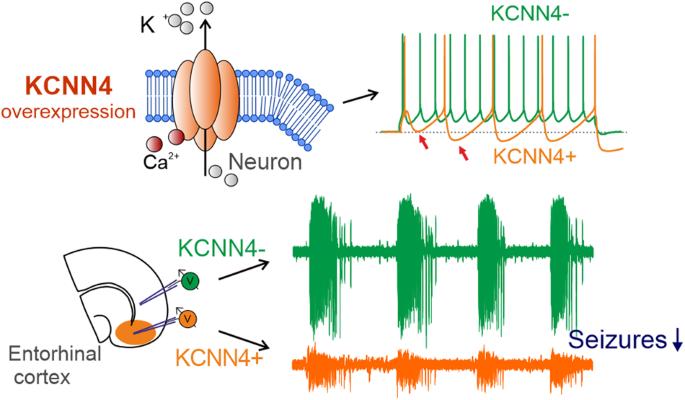主神经元中KCNN4通道的过表达在不降低其编码能力的情况下产生抗癫痫作用。
IF 4.6
3区 医学
Q1 BIOCHEMISTRY & MOLECULAR BIOLOGY
引用次数: 0
摘要
基因疗法为手术治疗癫痫提供了一种潜在的替代方案。癫痫影响着数百万人,约30%的病例具有耐药性。为了降低主要神经元的兴奋性,由于K+通道对神经元超极化的突出能力,已经提出了K+通道的工程化表达作为一种治疗方法。然而,K+通道过表达对细胞生理的影响仍有待研究。在这里,我们报道了一种腺相关病毒(AAV)载体,通过表达人类Ca2+门控K+通道KCNN4 (KCa3.1),专门降低兴奋性锥体神经元的癫痫样活性。急性脑切片的电生理和药理学实验表明,kcnn4转导的细胞表现出Ca2+依赖性的慢后超极化,这显著降低了kcnn4阳性神经元产生高频尖峰序列的能力,而不影响其低频编码能力和动作电位形状。抗癫痫活性试验显示,在体外,在单细胞和局部场电位水平上,药物诱导的癫痫发作具有有效的抑制作用,并在发作放电期间减少尖峰。综上所述,我们的研究结果强烈表明,兴奋性神经元中基于aav的KCNN4通道表达是一种有希望的癫痫基因治疗干预措施。本文章由计算机程序翻译,如有差异,请以英文原文为准。


Overexpression of KCNN4 channels in principal neurons produces an anti-seizure effect without reducing their coding ability
Gene therapy offers a potential alternative to the surgical treatment of epilepsy, which affects millions of people and is pharmacoresistant in ~30% of cases. Aimed at reducing the excitability of principal neurons, the engineered expression of K+ channels has been proposed as a treatment due to the outstanding ability of K+ channels to hyperpolarize neurons. However, the effects of K+ channel overexpression on cell physiology remain to be investigated. Here we report an adeno-associated virus (AAV) vector designed to reduce epileptiform activity specifically in excitatory pyramidal neurons by expressing the human Ca2+-gated K+ channel KCNN4 (KCa3.1). Electrophysiological and pharmacological experiments in acute brain slices showed that KCNN4-transduced cells exhibited a Ca2+-dependent slow afterhyperpolarization that significantly decreased the ability of KCNN4-positive neurons to generate high-frequency spike trains without affecting their lower-frequency coding ability and action potential shapes. Antiepileptic activity tests showed potent suppression of pharmacologically induced seizures in vitro at both single cell and local field potential levels with decreased spiking during ictal discharges. Taken together, our findings strongly suggest that the AAV-based expression of the KCNN4 channel in excitatory neurons is a promising therapeutic intervention as gene therapy for epilepsy.
求助全文
通过发布文献求助,成功后即可免费获取论文全文。
去求助
来源期刊

Gene Therapy
医学-生化与分子生物学
CiteScore
9.70
自引率
2.00%
发文量
67
审稿时长
4-8 weeks
期刊介绍:
Gene Therapy covers both the research and clinical applications of novel therapeutic techniques based on a genetic component. Over the last few decades, significant advances in technologies ranging from identifying novel genetic targets that cause disease through to clinical studies, which show therapeutic benefit, have elevated this multidisciplinary field to the forefront of modern medicine.
 求助内容:
求助内容: 应助结果提醒方式:
应助结果提醒方式:


